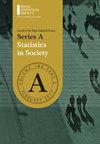Temporal analysis of hospital network data by hierarchical Bayesian p2 models with covariates
IF 1.5
3区 数学
Q2 SOCIAL SCIENCES, MATHEMATICAL METHODS
Journal of the Royal Statistical Society Series A-Statistics in Society
Pub Date : 2023-03-31
DOI:10.1093/jrsssa/qnad036
引用次数: 0
Abstract
Motivated by an application about interhospital connections, we propose a modelling approach for data referred to a temporal network. The approach may be seen as an extension of the one recently proposed in Bianchi et al. [(2020). Longitudinal networks of dyadic relationships using latent trajectories: Evidence from the European interbank market. Journal of the Royal Statistical Society: Series C, 69(4), 711–739] and, in turn, of the popular p1 and p2 models by Holland and Leinhardt [(1981). An exponential family of probability distributions for directed graphs. Journal of the American Statistical Association, 76(373), 33–50] and van Duijn et al. [(2004). p2: A random effects model with covariates for directed graphs. Statistica Neerlandica, 58(2), 234–254], on which the latter is built. The proposed extension consists in the introduction of covariates and in the adoption of a hierarchical Bayesian inferential approach that shows advantages in the specific application. For Bayesian inference we rely on a Markov chain Monte Carlo algorithm that produces samples from the posterior distribution of the model parameters. The application is based on original data on patient referral relations among 127 hospitals serving a large regional community of patients in Italy from 2014 to 2018. Results indicate that interhospital collaborative behaviours are primarily local and that collaborative attitudes vary at different time occasions of the considered period and in accordance with the level of competition faced by hospital organisations.带协变量的层次贝叶斯p2模型对医院网络数据的时间分析
在一个关于医院间连接的应用程序的激励下,我们提出了一种涉及时间网络的数据建模方法。该方法可以被视为Bianchi等人最近提出的方法的扩展[(2020)]。使用潜在轨迹的二元关系的纵向网络:来自欧洲银行间市场的证据。皇家统计学会杂志:C辑,69(4),711-739],以及Holland和Leinhardt的流行的p1和p2模型[(1981)]。有向图的概率分布的指数族。统计学报,76(373),33-50]及van Duijn et al.[2004]。带协变量的有向图随机效应模型。荷兰统计,58(2),234-254],后者是建立在此基础上的。提出的扩展包括引入协变量和采用分层贝叶斯推理方法,该方法在特定应用中显示出优势。对于贝叶斯推理,我们依靠马尔科夫链蒙特卡罗算法,该算法从模型参数的后验分布中产生样本。该应用程序基于2014年至2018年在意大利为大型区域患者社区服务的127家医院的患者转诊关系的原始数据。结果表明,医院间的合作行为主要是局部的,合作态度在研究期间的不同时间场合和医院组织所面临的竞争水平上有所不同。
本文章由计算机程序翻译,如有差异,请以英文原文为准。
求助全文
约1分钟内获得全文
求助全文
来源期刊
CiteScore
2.90
自引率
5.00%
发文量
136
审稿时长
>12 weeks
期刊介绍:
Series A (Statistics in Society) publishes high quality papers that demonstrate how statistical thinking, design and analyses play a vital role in all walks of life and benefit society in general. There is no restriction on subject-matter: any interesting, topical and revelatory applications of statistics are welcome. For example, important applications of statistical and related data science methodology in medicine, business and commerce, industry, economics and finance, education and teaching, physical and biomedical sciences, the environment, the law, government and politics, demography, psychology, sociology and sport all fall within the journal''s remit. The journal is therefore aimed at a wide statistical audience and at professional statisticians in particular. Its emphasis is on well-written and clearly reasoned quantitative approaches to problems in the real world rather than the exposition of technical detail. Thus, although the methodological basis of papers must be sound and adequately explained, methodology per se should not be the main focus of a Series A paper. Of particular interest are papers on topical or contentious statistical issues, papers which give reviews or exposés of current statistical concerns and papers which demonstrate how appropriate statistical thinking has contributed to our understanding of important substantive questions. Historical, professional and biographical contributions are also welcome, as are discussions of methods of data collection and of ethical issues, provided that all such papers have substantial statistical relevance.

 求助内容:
求助内容: 应助结果提醒方式:
应助结果提醒方式:


